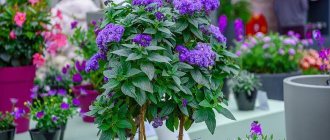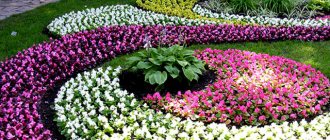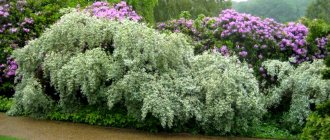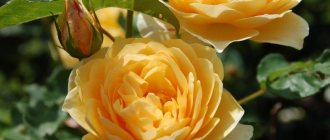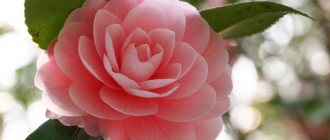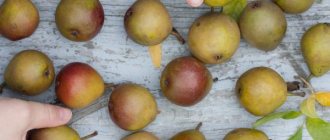In landscape design, the unique Volzhanka flower can occupy a central place thanks to the chic size of the green crown with openwork foliage and exquisite, incredibly decorative paniculate inflorescences. The plant is attractive for its unpretentiousness, frost resistance, and drought resistance.
Description of the Volzhanka flower
This genus of dioecious herbaceous perennials belongs to the Rosaceae (Rose) family. An alternative scientific name for Volzhanka is Arunkus. About 12 species of plants belonging to this family are known, growing mainly in light forests of the temperate climate zone of the Northern Hemisphere. It is found in the subalpine high-altitude mountain zone. The Volzhanka flower has been used as an ornamental crop since the 18th century.
What does the Volzhanka plant look like?
The lush, beautifully flowering perennial is easy to find on the site due to its excellent decorative characteristics. There are also compact forms in the family, but the most widespread is the dioecious plant Volzhanka, which grows within a season to the size of a small tree. Let's look at a brief description of a unique flower:
- The shape of the foliage is pinnately dissected, the blades have jagged edges, and there are no stipules.
- The flowers are predominantly dioecious, but bisexual species are also found.
- Inflorescences are complex paniculate.
- The lower part of the receptacle (hypanthium) is saucer-shaped.
- The corollas are white or pale yellow.
- Petals 5 pcs.
- Stamens 15-30 pcs.
- Pistils 3-5 pcs. in the form of curved columns, in male flowers the pistils are underdeveloped.
- The Volzhanka flower produces fruits in the form of leaflets with a leathery shell.
- The seeds are small, rod-shaped.
- Stem height – up to 2 m.
- The rhizomes are thick.
- Flowering period – June-July.
- The Volzhanka flower has a wonderful honey-vanilla aroma.
Volzhanka flower varieties
There are relatively few representatives in the decorative family, but there are noticeable differences between them in the height of the crown, the shape of the foliage or the color of the paniculate inflorescences. We offer you to study descriptions of the most common varieties of this crop:
- Garden flower Volzhanka dioecious
- branched stems, height up to 2 m, dissected leaves, inflorescence color white and cream. - The Volzhanka dill-leaved plant
(parsley-leaved, cory-leaved) is the most compact form, up to 27 cm in height, the color of the inflorescences is creamy white. The foliage is intricately pinnate, bright green in spring, and turns orange in fall. - American Volzhanka flower
- shoot height 0.8-1.1 m, inflorescence length up to 30 cm, crown compact and neat, carved light green foliage. - Asian Volzhanka
- plants are powerful up to 2-3 m, the color of the foliage is rich green, the shape of the leaves is pinnate, the roots are small, the inflorescences are compact. - Volzhanka Kamchatka plant
- stem height is up to 1.2-1.5 m, bipinnate leaves are narrow oval or oval-rounded, the color of the inflorescences is white. - Volzhanka Waldemar Meyer
is a hybrid variety up to 0.5 m in height, dark foliage, white and pink panicles, flowering period up to 40 days.
Planting a Volzhanka flower
It is not recommended to place seedlings of this crop too densely. Mature bushes grow strongly and will shade neighboring specimens, inhibiting them in the process of growth. It is necessary to take into account the characteristics of the variety. The cory-leaved Volzhanka, hybrids Waldemar Mayer, Johannisfest have minimal dimensions. The landing process is extremely simple:
- The hole is dug with dimensions of 0.5x0.5x0.5 m.
- The intervals between bushes are from 0.8-1 m.
- It is better to use soil based on compost and the top fertile layer of garden soil.
- The soil in the hole should be moistened.
- Spread the roots, sprinkle with the prepared substrate, and lightly compact the soil with your hands.
- Finish planting the Volzhanka plant with watering, after which cover the ground with mulch.
Watering, fertilizing, pruning
The aruncus bush grows rapidly in size from early May to mid-summer, when peak flowering occurs. It is advisable, but not necessary, to feed the plant once every 2-3 weeks. It is better to apply organic matter and mineral fertilizers one at a time.
Young plants that are planted in holes with humus do not need feeding in the first year.
If there is not enough moisture, growth and flowering will slow down. During dry periods, care will require more time: you need to water both the transplanted cuttings and adult plants.
Faded panicles are cut off so that the shoots and leaves are not crushed.
But the flowering is over. Now you can apply one of the phosphorus-potassium fertilizers under the bush.
Volzhanka flower - care
If the place for growing aruncus is chosen well and the planting is done in compliance with the rules, then this plant will not cause much trouble during the season. We list the main operations that are required in caring for a flower:
- In the hot season, the herbaceous plant Volzhanka needs watering; drying out of the soil leads to curling of the leaf plates. Up to 3 buckets of water should be poured under an adult plant at a time.
- Arunkus loves organic fertilizers. In the fall, humus and compost can be scattered in the root zone. In early spring, Volzhanka is fertilized with complex mineral preparations. During the flowering season, fertilizing based on chicken manure is beneficial.
- In harsh climates, it is recommended to cover the root part of the Volzhanka flower with foliage or peat after cutting the green mass.
Volzhanka plant - pruning
During the warm season, special operations to shorten the green mass are not required. Growing a Volzhanka plant is not a tedious task and does not take much time from gardeners. Pruning of ornamental bushes is performed twice a year:
- Pruning at the end of flowering to remove faded flower stalks.
- Before wintering, you should cut off the entire above-ground part of the Volzhanka flower, leaving stubs of 6-7 cm.
Location
Volzhanka can grow in the shade, however, the flowering time is shifted by at least a week. The plant grows well in a sunny place, but protected from direct rays, if the soil is sufficiently moist and nutritious. However, the most comfortable place for rapid development and flowering is partial shade.
It is advisable to plant Volzhanka in partial shade.
Volzhanka flower propagation
Arunkus seedlings can be obtained using several methods at once. The best results are obtained by vegetative propagation, but in the absence of a good overgrown mother bush, you can grow the required number of plants from seeds. Let's look at proven methods for propagating Volzhanka flowers:
- Dividing the mother bushes
. This is an extremely simple and effective method that can be used in early spring or mid-autumn. The plant is suitable for at least three years of age. The Volzhanka flower must be carefully dug up, then the roots should be divided into equal sections with a pair of replacement buds. The sections must be treated with fungicides, after which the cuttings should be planted in the prepared area. - Seed propagation
. For complete pollination of flowers, the presence of male and female specimens of the dioecious Volzhanka flower is required. The material should be collected in late autumn and planted in early spring. Sowing is done in boxes using a mixture of sand, vermiculite, soil, peat and humus (1:1:1:1:1). Planting into a shrub should be carried out after the formation of 2 or more leaves with an interval of up to 15 cm. Transplanting into a flower bed is recommended after two years. - Cutting method
. Material taken from the tops of the plant is better suited. Green Volzhanka cuttings should be planted in a shady, damp place and watered abundantly. Transplant from the school to the flowerbed after complete rooting. A greater yield of seedlings is obtained by forcing cuttings in a homemade greenhouse using stimulants.
Volzhanka transplantation
The root system of this crop has specific characteristics. It quickly grows in breadth and becomes woody. When trying to dig an adult aruncus out of the soil, most of the branched roots are damaged in most cases. Normal transplantation is possible only before the age of 2 years. If you want to move a perennial Volzhanka plant to a new place, it is better to divide the rhizome into full-fledged parts with developed buds. As a result, a small young organism emerges, which will quickly grow green mass and catch up in volume with the mother bush.
Features of Arunkus
Arunkus is a large herbaceous plant that is a perennial. Within one season, it is able to grow a thick green mass. That is why most gardeners perceive it as a monumental subshrub. In nature, it can often be found in the Northern Hemisphere in regions with a temperate climate.
The highly branched root system of this plant is superficial. With age, the diameter of the root system increases significantly, and the roots themselves become lignified. In autumn, with the onset of frost, the death of skeletal branches is not observed, but all the foliage flies off.
An adult bush has a height of 100 to 150 cm, and its diameter reaches no more than 120 cm. However, young aruncus does not grow very quickly. Powerful shoots are erect. The stems are completely covered with rich green leaves with carved edges, their petioles are long.
In the upper part of the branches, flower stalks grow, which reach a length of 0.3 to 0.6 m. The branched spike-shaped inflorescence consists of many small sessile flowers of cream or white color. Both female and male flowers are formed on the same bush. Female flowers are arranged loosely and have an openwork edge, while male flowers grow more densely and look more magnificent. The flowers reach about 0.3 cm in size. They have a pale green tint due to the prominent perianths. The bushes bloom from June to the first days of July. The flowers have a sharp, tart aroma that attracts insects to the garden. In the first autumn weeks, fruits are formed, which are leaflets containing dust-like seeds inside.
Unpretentious plants for the Volzhanka garden
Volzhanka flower diseases
The ornamental crop is considered by gardeners to be extremely resistant to infections; shrubs are rarely affected by fungi and attract little pests. The main danger for this plant is considered to be sawflies, which can turn openwork foliage in a short time into a net eaten by pests. For the purpose of prevention, the Volzhanka vulgare flower should be treated in problem seasons with insecticides “Intavir”, “Confidor”, “Karate”, “Aktara” or proven analogues.
Why do Volzhanka flowers quickly wither?
Even the most unpretentious crops in unfavorable conditions have problems with development, bud formation, pollination and fruit set. The perennial Volzhanka flower is no exception. Consider a list of common reasons that affect the length of the flowering period:
- Planting in bright sun in a southern climate has a negative effect on the development of aruncus. In the heat, the foliage often turns pale, loses its elegant appearance, the growth of shoots slows down, the inflorescences bloom more slowly and fade faster.
- The Volzhanka flower grows normally in wetlands, but does not tolerate drought well. With insufficient watering, the soil cover dries out, which will invariably affect the decorative appearance of paniculate peduncles.
- Volzhanka flowers look impressive when cut, but they live in vases for no more than three days. It is better to dry the panicles-inflorescences without water, using them to decorate rooms as beautiful dried flowers.
- Sawfly infestation leads to the loss of leaf blades; the bush, heavily eaten by pests, becomes sick and cannot feed a large number of flower stalks, which is why the panicles become small, underdeveloped and wither faster.
Growing conditions
Volzhanka is a forest plant, so it is naturally adapted to life in diffused light and copes well in shaded areas. It prefers semi-shaded or shady places and can grow successfully where other plants cannot survive due to lack of sunlight. Planted in a sunny place, it grows weaker and blooms less profusely. You can plant Volzhanka on very moisture-intensive soils and in sunny places, but the flowering period will be shorter.
Volzhanka is a forest plant, and the soil in the forest has its own specifics. Firstly, it is permeable, secondly, the amount of organic matter is huge, thirdly, the moisture content of forest soils is much higher than that of garden soils, fourthly, these are slightly acidic soils. If we manage to fulfill these 4 conditions in the garden, the plant will grow beautifully.
The soil for Volzhanka should be:
- fertile;
- humus, nutritious;
- permeable;
- sufficiently moist;
- have a slightly acidic reaction.
The plant forms a strong, strong root system, so it will develop worse on heavy soils. Volzhanka does not tolerate soil:
- dry;
- sandy;
- poor.
The structure and quality of poor soil can be improved by adding well-decomposed compost and acidic peat.
The bush reaches quite large sizes, so you need to take its size into account and prepare a suitable position accordingly.
Volzhanka plant in landscape design
It should be remembered that tall forms of aruncus quickly grow powerful green mass, suppressing all neighbors. It is optimal to plant the ornamental Volzhanka plant as a tapeworm, in the corner of a plot, in the background of a flower bed or near a fence. Due to the fact that the perennial is able to grow in slightly marshy soil, it is suitable for growing near the shores of a reservoir. You can use the shade-tolerant qualities of the crop by planting bushes under the canopy of trees.
Examples of using the Volzhanka flower in the garden:
- Volzhanka flower in a composition near the wall of the house.
- Volzhanka as a spectacular tapeworm.
- Volzhanka flower under the crown of a tree.
- Volzhanka near the pond.
- Volzhanka in the background of a voluminous flower garden.
What colors does Volzhanka go with?
In the process of creating garden compositions, you need to take into account the size of the annually growing decorative perennial, the color of the leaves and panicles-inflorescences. Since the aruncus plant in group plantings is often located in the background, it is better to combine it in flower beds with low crops. Excellent options are considered to be adjacent to dwarf varieties of astilbe, hostas, ferns, and shieldweed. This culture always looks advantageous next to conifers.
Not only beds and flower beds
Harmony and tranquility, connection with living nature - these are the goals that a garden or part of it, enriched with landscape design, serves.
Volzhanka dioecious can be used in various variations:
- a single bush creating a spectacular white spot;
- in shade or partial shade with other perennials that have contrasting colors;
- next to bushes and trees: filling the voids between them, it creates a harmonious transition of palette and levels;
- in compositions with stones, household items, garden decorations, wooden elements;
- for decorating the banks of a natural or artificial reservoir;
- after curly pruning, as an unusual garden decoration.
The carved leaves of Volzhanka dioica are beautiful in themselves, so even a non-flowering plant will decorate the garden. Airy inflorescences can be used as an addition to a bouquet; they can easily replace the usual gypsophila and asparagus. However, the plant will wither within three days. But dried flowers will be durable and effective. During flowering, the white branches of the inflorescences (brown in late autumn) must be cut off and dried in a dry room without water. You can use a vase without water or hang it. A decorative dry bouquet, a painting made from natural materials, a panel - inflorescences can be used in different ways.
Caring for Volzhanka dioecious is a noble process, since it responds immediately to care (fertilizer, watering, replanting). This perennial will delight you for many years with simple care. Therefore, if there is an untidy piece of land in the garden or an uncomfortable-looking fence, then Volzhanka dioecious will be an ideal remedy for solving these problems.



